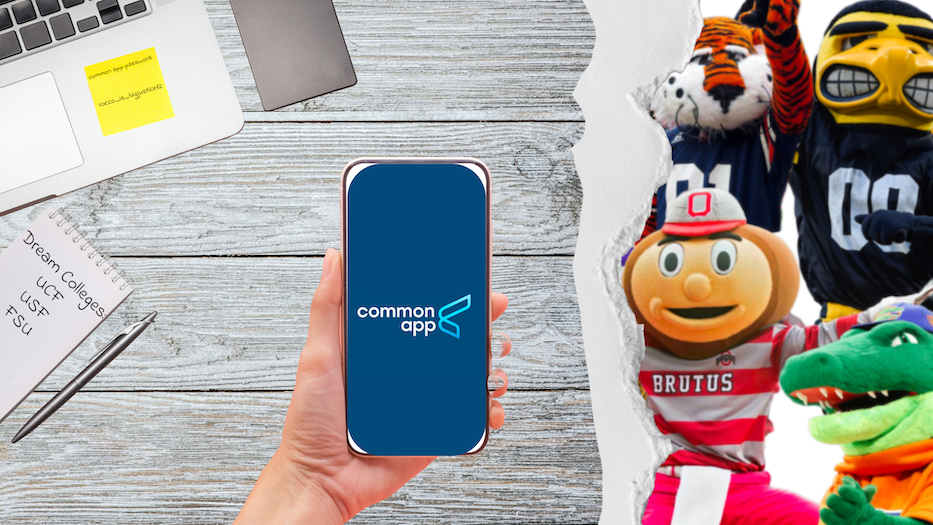By Aspen McAdoo
Once junior year comes to an end and maybe even before that, many high school students have to start thinking about the dreaded college application process. But this process starts to ramp up during a student’s senior year. As much as students dislike the process, it is a must for students looking to further their education. This process requires a lot of tedious details and can become very time-consuming for students. The main application students use to help them apply for college is the Common App.
The Common App is the primary application used by most colleges in the U.S. and this application allows students to provide all the information that generally every college requires in one place. Students will also provide their general college essay along with all this information. Once complete, students can send their Common App to the school they want to apply to, and answer any specific questions the college requires, and their application for that college is complete. At Ponte Vedra High School (PVHS) students are also able to connect their Common App account to an application called Xello. Xello allows students’ guidance counselors to track where they are in the application process and provide help when needed. Xello is also where students can request transcripts when needed. Now, while these applications might make the process seem like a breeze, it can also become time-consuming and difficult.
Bright Futures is a big deal for students who attend high school in Florida because it is essentially free money. Almost every state college or college in the state of Florida accepts Bright Futures; even private schools accept at least a portion of it. Bright Futures covers tuition and any other applicable fees. There are two levels to Bright Futures. Florida Academic Scholars (FAS), which students receive 100 percent of possible costs, and Florida Medallion Scholars (FMS), which covers 75 percent of possible costs. FAS requires a 3.5 weighted GPA, a 29 ACT or 1340 SAT, and 100 volunteer or paid work hours. FMS requires a 3.0 weighted GPA, a 25 ACT or 1210 SAT, and 75 volunteer or paid work hours.
When thinking about the college application process, the thing that jumps out to most students is the college essay. Many students don’t know what to write about, how formal it should be, or how many paragraphs it should be. Making the essay one of the most daunting things during the process. Ms. Jenifer Lee, college and career planning advisor, said, “I recommend students just to be themselves when writing their essay and throughout the process. Don’t hide anything; colleges want to see who you truly are.” Sometimes, students stress too much trying to appear perfect instead of focusing on who they truly are. There are also many mistakes that students can make when applying. Some of these mistakes are being dishonest or showing a negative character, missing deadlines, lack of effort, and not showing a specific interest.
Many students applying to colleges start taking standardized tests (ACT or SAT) in their junior year of high school, and some of them still take them during the fall of their senior year. These scores play a significant factor in what school students get accepted into. Ashtan Augusta, a senior at PVHS, said, “The most stressful thing throughout this process has been the SAT. The essay and the actual process of applying to schools hasn’t been that hard, but it’s very time-consuming.” These tests mean so much to kids that that’s where they put a lot of their time and energy into trying to get the best score they can.
“The most stressful thing throughout this process has been the SAT. The essay and the actual process of applying to schools hasn’t been that hard, but it’s very time-consuming.”
Ashtan Augusta (12)
This process is very detailed, and there are a lot of steps that students can miss if they don’t pay attention. These small details are what make students dread this process. James O’Donnell, a senior at PVHS, said, “The process is very time-consuming because of these tiny details. There is no possible way to rush through it because you could end up missing a very important detail.” These tedious steps, in a way, shape people for what their future is going to be like cause much of life is very tedious, and people don’t want to miss anything important.
Whether students are doing this process because they can’t wait to get to college or because their parents are making them go to college, no one enjoys this long, time-consuming process. But at the end of the day, it pays off for the majority of people because it sets them up for their future. The college process is a one-time thing that no one will ever worry about again after decision day comes.
Important Parts of the College Application Process:
- Family Educational Rights and Privacy Act (FERPA): is a privacy act that protects the privacy of a student’s educational record. When applying to schools there is an option to waive these rights and let colleges view a student’s records.
- Free Application for Federal Student Aid (FAFSA): is an application students can fill out to be considered for federal aid.
- Supplementals: these are additional essays or questions a college might ask a student to complete that are specific to the school.
- Deadline Dates: these are the dates students have to submit their completed applications by.
- Rolling Admissions: instead of classic admissions there is a deadline for applicants and then the admissions office looks at all of the applications after the deadline. Rolling admissions looks at a student’s application right when a student submits it and releases a decision once they have their verdict.
- Early Decision: This is when a student applies to one school early on in their senior year and agrees to attend the school if admitted. These applications are considered binding meaning students won’t be applying to any other schools.
- Early Action: This is similar to an early decision but there is no limit on the number of colleges a student can apply to and there is no binding agreement. Students typically apply for early action in the middle to late fall and hear back at the beginning of winter. So, it gives a student more time to make their decision.





